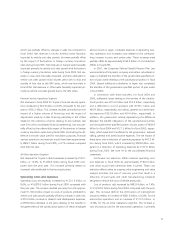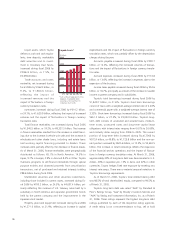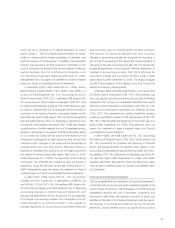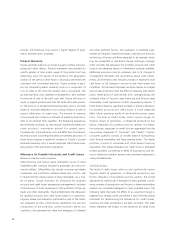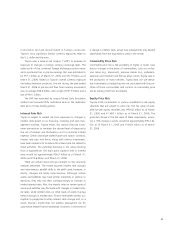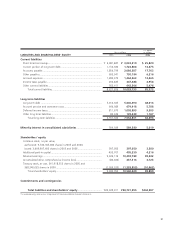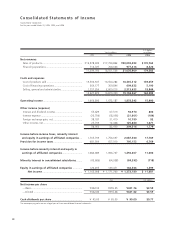Toyota 2006 Annual Report Download - page 83
Download and view the complete annual report
Please find page 83 of the 2006 Toyota annual report below. You can navigate through the pages in the report by either clicking on the pages listed below, or by using the keyword search tool below to find specific information within the annual report.
81
costs may be so abnormal as to require treatment as current
period charges...”. FAS 151 requires that those items be recog-
nized as current-period charges regardless of whether they
meet the criterion of “so abnormal.” In addition, this Statement
requires that allocation of fixed production overheads to the
costs of conversion be based on the normal capacity of the pro-
duction facilities. FAS 151 is effective for inventory costs
incurred during fiscal years beginning after June 15, 2005.
Management does not expect this statement to have a material
impact on Toyota’s consolidated financial statements.
In December 2004, FASB issued FAS No. 123(R), Share-
Based Payment (revised 2004) (“FAS 123(R)”). FAS 123(R) is a
revision of FASB Statement No. 123, Accounting for Stock-
Based Compensation (“FAS 123”), supersedes APB Opinion No.
25, Accounting for Stock Issued to Employees (“APB 25”), and
its related implementation guidance. FAS 123(R) requires a pub-
lic entity to measure the cost of employee services received in
exchange for an award of equity instruments based on the
grant-date fair value of the award. That cost will be recognized
over the period during which an employee is required to pro-
vide service in exchange for the award. FAS 123(R) also requires
a public entity to initially measure the cost of employee services
received in exchange for an award of liability instruments based
on its current fair value; the fair value of that award will be
remeasured subsequently at each reporting date through the
settlement date. Changes in fair value will be recognized as
compensation cost over that period. Although Toyota is
required to implement the standard as of the beginning of the
first interim or annual period that begins after June 15, 2005
under Statement No. 123(R), the Securities and Exchange
Commission has amended the compliance date and Toyota is
required to adopt the Standard for the year ending March 31,
2007. Management does not expect this statement to have a
material impact on Toyota’s consolidated financial statements.
In May 2005, FASB issued FAS No. 154, Accounting
Changes and Error Corrections—a replacement of APB No. 20
and FAS No. 3 (“FAS 154”). FAS 154 replaces APB Opinion No.
20, Accounting Changes, and FASB Statement No. 3, Reporting
Accounting Changes in Interim Financial Statements, and
changes the requirements for the accounting for and reporting
of a change in accounting principle. FAS 154 applies to all vol-
untary changes in accounting principle. It also applies to
changes required by an accounting pronouncement when the
pronouncement does not include specific transition provisions.
APB Opinion 20 previously required that most voluntary
changes in accounting principle be recognized by including in
net income of the period of the change the cumulative effect of
changing to the new accounting principle. FAS 154 requires ret-
rospective application to prior periods’ financial statements of
changes in accounting principle. FAS 154 is effective for
accounting changes and corrections of errors made in fiscal
years beginning after December 15, 2005. The impact of apply-
ing FAS 154 will depend on the change, if any, that Toyota may
identify and record in future periods.
In February 2006, the FASB issued FAS No. 155, Accounting
for Certain Hybrid Instruments (“FAS 155”), which permits, but
does not require, fair value accounting for any hybrid financial
instrument that contains an embedded derivative that would
otherwise require bifurcation in accordance with FAS No. 133,
Accounting for Derivative Instruments and Hedging Activities
(“FAS 133”). The statement also subjects beneficial interests
issued by securitization vehicles to the requirements of FAS 133.
FAS 155 is effective after the beginning of first fiscal year that
begins after September 15, 2006. Management does not
expect this statement to have a material impact on Toyota’s
consolidated financial statements.
In March 2006, the FASB issued FAS No. 156, Accounting
for Servicing of Financial Assets (“FAS 156”), which amends FAS
No. 140, Accounting for Transfers and Servicing of Financial
Assets and Extinguishments of Liabilities, with respect to the
accounting for separately recognized servicing assets and servic-
ing liabilities. FAS 156 is effective as of the beginning of first fis-
cal year that begins after September 15, 2006, with earlier
adoption permitted. Management does not expect this state-
ment to have a material impact on Toyota’s consolidated finan-
cial statements.
Critical Accounting Estimates
The consolidated financial statements of Toyota are prepared in
conformity with accounting principles generally accepted in the
United States of America. The preparation of these financial
statements requires the use of estimates, judgments and
assumptions that affect the reported amounts of assets and
liabilities at the date of the financial statements and the report-
ed amounts of revenues and expenses during the periods
presented. Toyota believes that of its significant accounting


